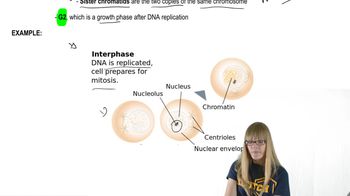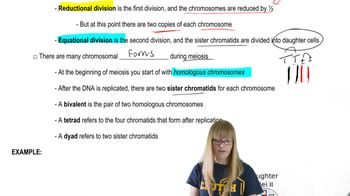Table of contents
- 1. Introduction to Genetics51m
- 2. Mendel's Laws of Inheritance3h 37m
- 3. Extensions to Mendelian Inheritance2h 41m
- 4. Genetic Mapping and Linkage2h 28m
- 5. Genetics of Bacteria and Viruses1h 21m
- 6. Chromosomal Variation1h 48m
- 7. DNA and Chromosome Structure56m
- 8. DNA Replication1h 10m
- 9. Mitosis and Meiosis1h 34m
- 10. Transcription1h 0m
- 11. Translation58m
- 12. Gene Regulation in Prokaryotes1h 19m
- 13. Gene Regulation in Eukaryotes44m
- 14. Genetic Control of Development44m
- 15. Genomes and Genomics1h 50m
- 16. Transposable Elements47m
- 17. Mutation, Repair, and Recombination1h 6m
- 18. Molecular Genetic Tools19m
- 19. Cancer Genetics29m
- 20. Quantitative Genetics1h 26m
- 21. Population Genetics50m
- 22. Evolutionary Genetics29m
9. Mitosis and Meiosis
Mitosis
Problem 26
Textbook Question
For Problems 25–30, consider a diploid cell that contains three pairs of chromosomes designated AA, BB, and CC. Each pair contains a maternal and a paternal member (e.g., A^m and A^p). Using these designations, demonstrate your understanding of mitosis and meiosis by drawing chromatid combinations as requested. Be sure to indicate when chromatids are paired as a result of replication and/or synapsis. You may wish to use a large piece of brown manila wrapping paper or a cut-up paper grocery bag for this project and to work in partnership with another student. We recommend cooperative learning as an efficacious way to develop the skills you will need for solving the problems presented throughout this text. During meiosis I, assuming no crossing over, what chromatid combination(s) will be present at the completion of prophase I? Draw all possible alignments of chromatids as migration begins during early anaphase.
 Verified step by step guidance
Verified step by step guidance1
Identify the chromosome pairs: AA, BB, and CC, each with a maternal (A^m, B^m, C^m) and a paternal (A^p, B^p, C^p) chromosome.
During prophase I of meiosis, homologous chromosomes pair up in a process called synapsis, forming tetrads. Each tetrad consists of two homologous chromosomes, each made up of two sister chromatids.
For each chromosome pair, align the maternal and paternal homologs: (A^mA^p), (B^mB^p), and (C^mC^p). Each homologous pair will consist of four chromatids.
At the completion of prophase I, the chromatids are paired as tetrads: (A^mA^p), (B^mB^p), and (C^mC^p). These tetrads are aligned along the metaphase plate.
As migration begins during early anaphase I, the homologous chromosomes (not sister chromatids) are pulled apart to opposite poles. This results in two possible alignments for each tetrad, leading to different combinations of maternal and paternal chromosomes in the resulting cells.
Recommended similar problem, with video answer:
 Verified Solution
Verified SolutionThis video solution was recommended by our tutors as helpful for the problem above
Video duration:
2mPlay a video:
Was this helpful?
Key Concepts
Here are the essential concepts you must grasp in order to answer the question correctly.
Mitosis
Mitosis is the process of cell division that results in two genetically identical daughter cells, each with the same number of chromosomes as the parent cell. It involves several stages: prophase, metaphase, anaphase, and telophase. During prophase, chromosomes condense and become visible, and the nuclear envelope breaks down. Mitosis is crucial for growth, repair, and asexual reproduction in organisms.
Recommended video:
Guided course

Mitosis Steps
Meiosis
Meiosis is a specialized form of cell division that reduces the chromosome number by half, resulting in four genetically diverse gametes. It consists of two rounds of division: meiosis I and meiosis II. During meiosis I, homologous chromosomes pair and can undergo crossing over, although the question specifies no crossing over. This process is essential for sexual reproduction and genetic diversity.
Recommended video:
Guided course

Meiosis Overview
Chromatid Pairing and Synapsis
Chromatid pairing occurs when replicated chromosomes align closely during cell division. In meiosis I, synapsis refers to the pairing of homologous chromosomes, forming structures called tetrads. This alignment is crucial for the proper segregation of chromosomes. Understanding these concepts helps visualize the chromatid combinations present during prophase I and the subsequent movements during anaphase.
Recommended video:
Guided course

Chromatin
Related Videos
Related Practice




